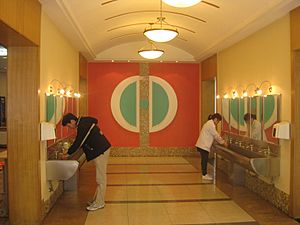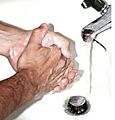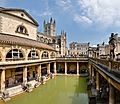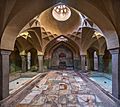Hygiene facts for kids

Hygiene is the act of being clean. Washing the body to remove dirt and germs, brushing the teeth to keep them clean, shaving, using the toilet properly, and dressing correctly are some examples. Proper hygiene is often taught to children at a young age, and it becomes a habit. People who do not have good hygiene might smell bad, lose teeth, or become ill (sick).
First proven use of the word in English was in 1677s. The word hygiene comes from the French word hygiène, which is western version of Greek word ὑγιεινή (τέχνη) - hugieinē technē, meaning "(art) of health", from ὑγιεινός (hugieinos), "good for the health, healthy", in turn from ὑγιής (hugiēs), "healthful, sound, salutary, wholesome". In ancient Greek religion, Hygeia (Ὑγίεια) was the person that represented health.
Related pages
Images for kids
-
Washing one's hands, a form of hygiene, is the most effective way to prevent the spread of infectious diseases
-
Solar water disinfection (SODIS) application in Indonesia using clear polyethylene terephthalate (PET) plastic beverage bottles
-
Roman public baths (Thermae) in Bath, England.
-
Byzantine Bath in Thessaloniki.
-
Ali Gholi Agha hammam, Isfahan, Iran.
See also
 In Spanish: Higiene para niños
In Spanish: Higiene para niños











